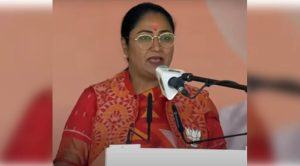Modi trying to recreate 2014 scenario to regain power in 2019

Photo: Twitter@BJP
Photo: Twitter@BJP
Lucknow: As the general elections are round the corner, Prime Minister Narendra Modi is on an inauguration and foundation stone laying spree to win over voters for his Bharatiya Janata Party (BJP).
And Modi is especially focussing on Uttar Pradesh that sends 80 members to the Lok Sabha. With the largest number of parliamentary seats, UP plays a vital role in the formation of a government at the Centre.
Given the “political significance” of the state with largest population in the country, Modi has launched RS 102,708 crore projects in UP and has visited the state numerous times in the last two months. With these announcements, MOdi is trying to recreate the 2014 scenario to return to power in 2019, say political analysts.
In 2014 parliamentary elections, the BJP had won 73 seats from the state.
During his visit to Vrindavan in Mathura on February 11, Modi served 3 billionth meal under the Akshaya Patra mid-day meal scheme at an event organised by the Akshaya Patra Foundation.
On February 15, he launched eight projects worth Rs 20,506 crore in Jhansi, which included the piped drinking water scheme for Bundelkhand, development of a defence corridor, the Bundelkhand Expressway and various railway projects.
On February 19, Modi inaugurated 47 projects worth Rs 3,382 crore.
On February 24, Modi chose Gorakhpur, which was the Lok Sabha constituency of Chief Minister Yogi Adityanath, to roll out Rs 75,000 crore Pradhan Mantri Kisan Samman Nidhi (PM-KISAN) scheme, an all-India programme.
The Prime Minister also launched, separately, the Rs 10,000 crore schemes for the district.
On March 8, Modi was back in the state to address a rally in Amethi, Lok Sabha seat represented by Congress President Rahul Gandhi, and kicked off the Rs 538 crore development projects.
Same day, he visited Varanasi, his own parliamentary constituency, and laid the foundation stone for the Kashi Vishwanath Dham Pariyojana, a Rs 380 crore renovation and rejuvenation scheme.
He also laid foundation stone for 11 projects worth Rs 1602,0.1989 crore and another six projects to be completed at the cost of Rs 703,0.056 crore.
Before returning to Delhi, the Prime MInister was in Ghaziabad to launch 14 development projects worth Rs 32,513 crore.
The Prime Minister continued his inauguration spree on March 9 (Saturday) and launched 11 schemes, including new phase of Noida Metro, which would connect Noida City Centre to Noida Electronic City.
Modi also laid the foundation stone for the Rs 12,000 crore Khurja Thermal Power Plant that will produce 1,320 megawatt electricity. He also inaugurated the Pandit Deendayal Upadhyaya Institute of Archaeology at Greater Noida, built with an investment of Rs 289 crore.
The foundation laying and project inauguration ceremonies underline the fact that Modi is seeking to strengthen his vote base in eastern (Purvanchal) part of the state, which has got a lion’s share of new programmes. The region accounts for 32 Lok Sabha seats in UP and impacts voting pattern in several adjoining seats in Bihar.
Another reason could be strong presence of the Samajwadi Party and the Bahujan Samaj Party in the area and the electoral pact between them to contest UP seats in alliance.
Says Premshankar Mishra, a senior political analyst, Modi is striving to garner as many seats as possible from the state. “His performance in 2014 in UP was historic. But equations have been changed in these five years. Also, he will have to answer voters’ questions on his performance.”
“Modi is trying to garner votes by playing development and nationalism cards. Nationalism issue is hot after the Pulwama attack and Modi is trying to showcase his ‘development’ image with this inauguration and stone laying spree,” said Mishra.
“Modi knows the way to prime minister’s office passes through UP,” he remarked.
IANS




